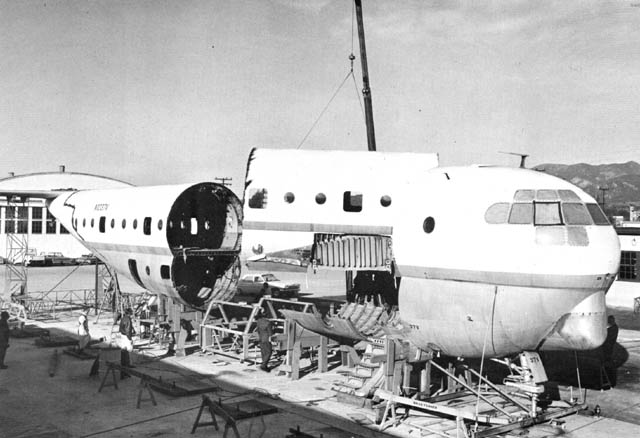 Aero Spacelines workmen dismantle three of Boeing 377 Stratocruisers for parts to build a Mini Guppy outsized cargo transport. Two larger aircraft in the series, the Pregnant Guppy and Super Guppy fly cargo for NASA and the Defense Dept. |
|
Mini
Guppy Begins Certification Testing
By George S. Hunter |
|
Santa Barbara, Calif.-Aero Spacelines, Inc., Mini Guppy has started
a flight test program aimed at Federal Aviation Administration certification
of the out-sized cargo transport this fall. Then, it plans to offer the
aircraft for civil and military charters. The Mini Guppy is the third of Aero Spacelines' family of outsized carriers that includes single Pregnant Guppy and Super Guppy versions. The earlier Guppys have been hauling Saturn 1 and Saturn 5 rocket stages and other bulky National Aeronautics and Space Administration and Defense Dept. hardware under exclusive NASA contracts. They went into service in May, 1963, and December, 1965, respectively. The Mini Guppy was constructed at the company's operating base at Santa Barbara Airport in less than seven months, from metal cutting to first flight, following three months of design and stress work. The thick. constant section fuselage has resulted in an aircraft with a more conventionally balanced profile than its more, whale-like predecessors exhibited. |
Like all aircraft in this series, the Mini Guppy is a custom conversion
of a basic Boeing Model 377 Stratocruiser. A phased-out stock of this type
of aircraft was acquired by Aero Spacelines from Pan American, North Western
and Transcontinental airlines several years ago, with 14 units still available.
Mini Guppy major assemblies and key design features include: *Nose section, wings with engines, small arc of the lower fuselage, empennage and the undercarriage, cannibalized from three stratocruisers. The engines have been overhauled to zero hours, the horizontal stabilizer was extended by 80 in., and the wing center section was replaced with a completely new, beefed-up structure manufactured on the premises and featuring 15 ft. extra width, thicker material gauges and a 50% greater cross-sectional area. The wider spacing from the aircraft centerline unloaded the wings by 20% from the original design level, permitting retention of original attachment fittings with the new |
center section. The new locations of engines and the main undercarriage, while providing
improved aircraft landing and takeoff crosswind stability and control,
resulted in excessive turning yaw-forces on the nosewheel. This has been
compensated by reassembling the oleo from selected parts which originally
had been over-designed in heat treatment. *All fuselage stringers and longerons were subcontracted. Fuselage skin was cut and riveted on the premises. *Mini Guppy swing-tail cargo loading and unloading modes include a number of simplified operating features. A single spar is manually lowered from the rear end of the fuselage and locked in place with double-shear pins for ground support. Holding clips and a number of locking nuts are then removed from 17 double-acting hydraulic jack pins joining the fuselage and the tail-section flanges. A twin-unit, solid-rim tailwheel is then lowered hydraulically and swung in a circle. The tail is swung |
|
Reprinted From AVIATION WEEK & SPACE TECHNOLOGY July 3, 1967 © Copyright 1967 McGraw-Hill, Inc. All rights reserved. Printed in U.S.A. 377MG | Page 1 | Page 2 | Page 3 | Page 4 Comments or Questions? Email me Copyright © 2006 Daren Savage All Rights Reserved |